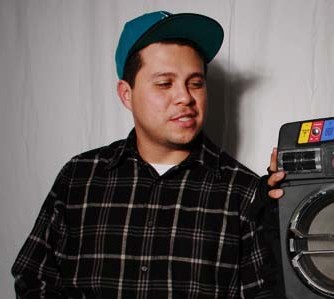Blog June 19, 2015
The History of Kumbias Editadas According to Turbo Sonidero
In case you ever want to feel high without drugs, listening or dancing to cumbia editada--or kumbia editada--is a pretty good option. As you hopefully already know, cumbia is a rhythm/musical genre of coastal Afro-Colombian origin that has spread across Latin America, the U.S. and beyond. The rhythm is simple and catchy, allowing for a plethora of stylistic offspring including accordion-driven vallenato, guitar-heavy Peruvian chicha, and more recently, a myriad of remixed digital forms, such as the kumbia editada you are about to hear. For a more in-depth look into the history of cumbia, listen to our Hip Deep program The Cumbia Diaspora and program Maestros de Cumbia. For an immediate hit of some heavy cumbia with a K, listen to this mix from Turbo Sonidero. Warning: the slow, grinding rhythms, pitch-shifted bass, guitar and accordion lines and eerie, floating vocals of this music may have body- and mind-altering effects:
This new mix by Turbo Sonidero, Kumbias Editadas: La Historia 2007-2010 Vol. 1 is a window into a fertile period in the history of this slow, psychedelic style of digital cumbia. According to the San José, CA-based producer, kumbia editada is a style of digital cumbia from San Luis Potosí, Mexico, which arose in the mid-2000s. For more details on this history, see our previous post based on conversation with Turbo Sonidero about the scene in San Luis Potosí. His recent mix focuses on the years 2007-10, and while Turbo Sonidero quite adamantly refuses to tell us what songs are being remixed ( "....NO there is no track list. Do your homework!!!"), he does give props to producers "Danni Mastah, Kiss Sound, Master Maniaco, Bamby Mater, Sonido Royal, etc. Respect to all the Kumbia Editada producers worldwide."
While, admittedly, we have plenty of homework to do about kumbia editada, to our ears, this style is similar but different from the slowed-down/chopped-and-screwed cumbia rebajada that evolved out of the DJ scene in Monterrey, in the north of Mexico. What distinguishes kumbia editada besides geography and history? Kumbia editada is more altered: It is more loop-based, more processed and full of pitch-shifted vocals and digital beats and effects, while cumbia rebajada tends to be more of a simple slowing down of the original. For contrast, enjoy over an hour of classic Andres Landero tunes at slower speeds and lower pitches. And don't forget to stay tuned to Turbo Sonidero Futuristo for volume two!









